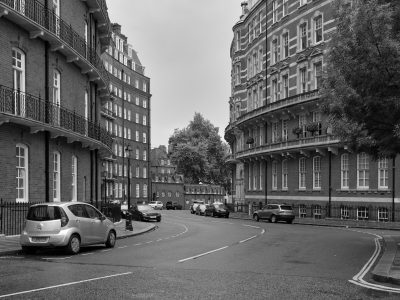The UK property market is blighted by a significant, worsening problem: empty buildings.
The number of empty buildings across the country is on the rise, and there is no easy way of addressing the issue. But it cannot be ignored.
Over the past six years, the number of vacant residential buildings has surged by a staggering 24%.
Simultaneously, the shift towards hybrid work models and heightened interest rates have cast a shadow over the demand for commercial properties, especially long-lease office spaces.
The escalating number of empty properties – commercial and residential alike – coincides with a persistent nationwide housing shortage, so the debate around how to address the problem has become increasingly important in both the public and private sectors.
To investigate the matter further, Market Financial Solutions (MFS) recently commissioned an independent survey of 2,000 UK adults. The survey delved into the regularity with which Britons encounter derelict and empty properties in their local area, their confidence in the government’s management of the issue, and the ways in which they think these buildings can be used best.
Britons recognise that the problem is getting worse
The data around the empty building epidemic paints a rather stark picture. A study by Leeds Building Society, for example, found that over 600,000 residential properties in the UK stand vacant at present, marking a 4% increase (or 23,000) in the past year alone.
Simultaneously, in the commercial property sector, 172,217 buildings sat empty nationwide in March 2020 – a figure that will have swelled significantly with the demand for commercial units has dropping significantly in the last three years.
These statistics demonstrate how bad the problem has become, a sentiment that is echoed in MFS’s own research. A quarter (25%) of UK adults say they have seen a surge in empty or dilapidated homes on their streets in the past five years. Furthermore, a substantial majority (58%) noted an uptick in empty properties along their local high streets during the same period.
As a consequence, over a third (34%) believe their local areas are suffering from an excess of dilapidated, empty, or derelict buildings.
But how would Britons like to see the problem be tackled?
Tackling the empty building epidemic
As the empty building predicament has intensified, various solutions have emerged to address it.
The Empty Homes Agency, for instance, advocates for the revitalisation and reintroduction of these properties into the market. This approach, they argue, not only bolsters the housing supply in the UK but will regenerate local communities with a reduced impact on the environment.
A significant 67% of respondents in MFS’s survey agree with this solution, emphasizing the need for government initiatives that encourage the purchase and renovation of dilapidated properties.
As for more drastic measures, 51% of Britons said that landlords who own properties that have been vacant for more than 12 months should be forced to sell them, and 61% believe that stronger regulations are needed to stop people from leaving their homes vacant or allowing them to slip into a state of dereliction.
This view is shared by the Labour party, which unveiled plans earlier this year to empower councils to impose a 300% council tax premium on landlords who leave their properties vacant for extended periods of time.
However, incentivising or penalising landlords will not comprehensively tackle the issue. Yet nor can the burden of renovating and reintroducing Britain’s vacant buildings to the market cannot rest solely on the shoulders of the public sector.
For the empty building epidemic to be properly addressed for the long-term, collaboration with the private sector will be key, providing landlords looking to ‘flip’ properties with some intriguing opportunities. So, how would the public like to see these buildings be used?
Revitalising the UK’s empty properties
For a substantial majority of Britons, converting vacant properties into new homes would be the preferred option. Three in four (74%) would support this.
Given the well-documented housing shortage in the UK, this inclination was less than surprising to uncover. Indeed, three in five (63%) respondents believe that putting these empty buildings back onto the property market stands out as the most effective strategy for bolstering housing supply.
In addition to the conversion into homes, the British public also expressed support for alternative uses of vacant properties. As many as 68% would be happy if empty properties were torn down to create more green areas, while 66% support repurposing them for community and shared spaces.
For commercial property investors, there is also encouraging appetite for new commercial units through the renovation of empty or derelict buildings. For instance, 51% of respondents in MFS’s survey express support for converting vacant properties into shops, and an equal number (51%) welcome the prospect of new hospitality venues being introduced to their local areas.
The widespread support for many different uses of empty buildings suggests that, ultimately, the UK public just wants to see these properties – or the land they are on – used in a way that will deliver value to their local community.
Facilitating the renovation and conversion of empty buildings
Empty buildings clearly hold a great deal of potential for investors, from both a residential and commercial perspective.
That being said, taking on ‘flipping’ projects can be difficult, so it is important that investors work closely with brokers and lenders in order to access fast and flexible financial products that will facilitate their projects in the years to come.
Indeed, lenders who can provide solutions like auction finance or permitted and light development bridging loans, along with buy-to-let mortgages, can play a pivotal role in breathing new life into local communities. The resulting increase in housing supply also has the potential to foster a more equitable housing market.
Looking ahead, a symbiotic relationship between the regulatory strength of the public sector and the innovation and investment capacity of the private sector is imperative if we are to effectively address the issue of empty properties.
Seizing the opportunity to repurpose these existing structures presents an exciting chance to tackle multiple challenges head-on – a chance that must not be overlooked by investors, brokers or lenders.

























Comments